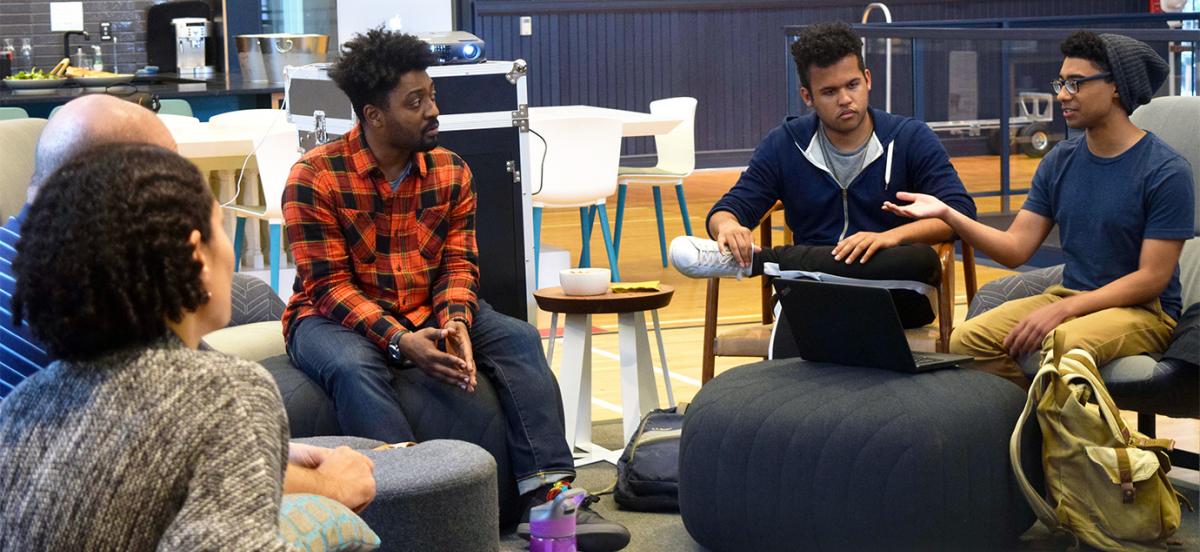Students Help Launch New Mentoring Program for Local Boys of Color

SURGE mentors host a "meet-and-greet" at a table in the VCAM lounge.
Details
SURGE, which stands for “Sons Uniting, Realizing Goals of Excellence,” is supported by Philadelphia Area Creative Collaboratives (PACC), a campus organization dedicated to encouraging and supporting student involvement in the greater community.
A pervasive sense of community lies at the heart of Haverford’s social scene. It’s something that shapes the way we take tests and talk to each other; it’s something that enables us to build relationships with our professors that go beyond just the classroom; it’s something that ensures that we clean up after ourselves at the dining center and return our library books on time. All too often, however, the term “community” is used to refer exclusively to those who live and work on campus, shutting out those beyond its borders in the process.
Educational initiative SURGE (Sons Uniting, Realizing Goals of Excellence) intends to broaden this campus-wide conception of “community”—and, with funding from campus institutions as varied as the Office of the President, the Office of Multicultural Affairs (OMA), the John B. Hurford ’60 Center for the Arts and Humanities (HCAH), the Center for Peace and Global Citizenship (CPGC), and Philadelphia Area Creative Collaboratives (PACC), it has the means to do so for the third year in a row.
The brainchild of Marcus Gaskins, a youth basketball coach, community leader, and co-owner of the Ardmore barbershop Gentleman’s Quarters, SURGE provides a support network for young Ardmore boys of color during the academic year, one that they can utilize as they navigate a world where they are often viewed with hostility because of the color of their skin. The backbone of this support network? Haverford men of color, like founding students Maurice Rippel ’19, Andrew Eaddy ’19, and Jhoneidy Javier ’19.
"Marcus reached out to Benjamin Hughes in the OMA with the idea of connecting young boys of color with young men of color from Haverford's campus,” Rippel says. “When Ben reached out to students that came to mind, I was one of them.”
More than that, Rippel sees himself, specifically, as a steward of Gaskins’s vision. “I thought SURGE was a great idea,” he says. “As a college and campus culture, we've gotten this mindset that we should go into Philadelphia or other parts of the world and ethically engage and support communities, but where is our involvement in the Ardmore community? The one right next door?”
Additionally, Rippel’s personal experience with mentor-mentee relationships told him that SURGE had the potential to genuinely change the lives of disadvantaged youth. “At Haverford specifically,” he says, “I've experienced and witnessed how positive mentoring relationships can provide better academic and socio-emotional [outlooks], formally through programs like the Chesick Scholars and the Mellon Mays Undergraduate Fellowship, and informally through the relationships one can have with faculty. Everyone deserves these same opportunities, which is why I wanted to bring SURGE into being.”
PACC program manager Stephanie Bursese feels the same way. She sees notable parallels between PACC’s mission and SURGE’s own. “Part of the PACC project mission is to create a non-hierarchical, reciprocal relationship between collaborators,” she says. “The PACC initiative has overlapping goals with the SURGE group, one of those being to recognize that we have a deeper commitment to serve our immediate community and, in addition, the broader Philadelphia community.”
In SURGE’s case, this means creating relationships between mentors and mentees that aren’t condescending, or exploitative, or parasitic—but based on mutual respect, and the realization that both parties have something to teach the other.
"In conversation with Jhoneidy and other SURGE mentors,” Bursese says, “they have communicated that they are also learning from the youth” even as they mentor them, providing them with advice on everything from “higher education, college, their feelings” to “what they want to do, what they’re working on,” as well as “being there for them as people in their community that they can go to, that they can talk to, in addition to their family members and their immediate friends.”
Javier, for his part, hopes that his efforts in this capacity will help the boys that he works with realize their full potential. “I [want] the boys that I mentor [to] realize that they are capable of so much more than the images and roles of black and brown men in the media and in general American culture [that are shown to them],” he says. “At SURGE, we try to expose the kids to different professions and roles that people of color in the US are culturally neglected from, i.e. entrepreneurship, academia, environmentalism, etc.”
Likewise, Rippel sees SURGE’s mission as a balance between acknowledging the societal prejudice men of color face and finding ways to rise above it it. “SURGE is about understanding how the world may see men of color,” he observes, “but [also about] finding a personalized vision of the activist, scholar, philanthropist, or community leader you can become.”
Rippel, Javier, and Bursese all believe that the program is something that could potentially expand beyond Ardmore into other locales—Rippel, in fact, is already in talks with other Philadelphia-area colleges to start SURGE chapters on their campuses. And who knows what might come after that?
"It's easy at Haverford to get absorbed in the day-to-day [details], the academic grind,” says Rippel. “But SURGE is a reminder of how much bigger [the picture] is, that we have privilege as men of color in undergraduate institutions and need to share it with our younger brothers.”



